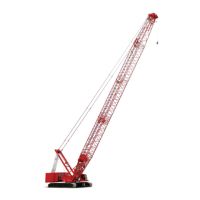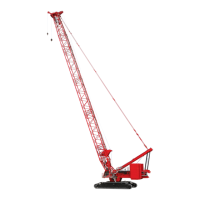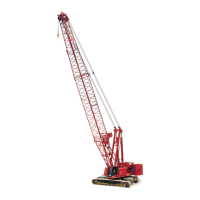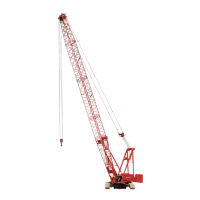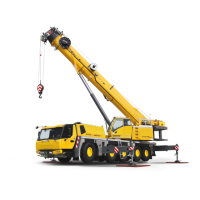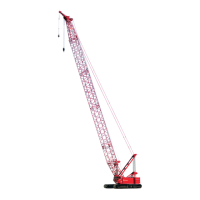Manitowoc Published 05-26-17, Control # 238-02 3-3
MLC165-1 SERVICE/MAINTENANCE MANUAL ELECTRICAL SYSTEM
Engine Node (Node 0)
The microprocessor within the engine node communicates
with the engine control module (ECM). Digital outputs drive
relays within the node that control power buses. Node 0 also
provides power and the serial communication connections to
the boom and jib remote input nodes (RINs).
Side Console Node (Node 2)
The microprocessor within the console node communicates
with low current control and display devices within the cab.
A/D converters allow the node to read analog input signals of
devices that have variable input levels, such as the hand and
foot throttles, and translate them to digital values that the
microprocessor can read. Digital inputs read the state of cab
control switches and free fall safety latch pedals. Digital
outputs drive the gauge panel, alarms, beacon, and control
handle thumpers.
Universal Nodes (Nodes 3–5)
The microprocessors within the universal nodes
communicate with the hardware controls, switches, and
sensors on the rotating bed.
A/D converters allow the node to read analog input signals of
devices that have variable input levels, such as pressure
transducers, and translate them to digital values that the
microprocessor can read.
Digital inputs read the state of input devices that are either
on or off. Digital outputs can drive devices that are either on
or off by sending a high or low signal. They may also drive
devices that use variable analog inputs by using pulse width
modulation (PWM) to vary the average signal level.
Encoder inputs read the pulses from incremental encoders
and convert them to digital values that can be read by the
microprocessor. These are used for rotational speed,
direction, and position sensing.
Pressure Transducers
A universal node provides power to a pressure transducer.
The pressure transducers produces an analog input signal to
the universal node that is proportional to the hydraulic
pressure at the transducer connection. The universal nodes
monitor hydraulic pressures to use as feedback in control
algorithms and to provide status information to the operator.
Pressure transducers are used to monitor:
• Control handle pressures
• Drum system pressures
• Swing system pressure
• Accessory system pressure
• Cooler fan pressure
Figure 3-4. Engine Node
M100793
RS-232
Analog
Inputs
Digital
Inputs
CAN Bus
Transceiver
Micro-
processor
Relays
Figure 3-5. Side Console Node
M100794
Micro-
processor
CAN Bus
Transceiver
Analog
Inputs
Digital
Inputs
Digital
Outputs
RS-232
Figure 3-6. Universal Node
M100795
Micro-
processor
CAN Bus
Transceiver
Analog
Inputs
Digital
Inputs
Digital
Outputs
RS-232
Encoder
Inputs

